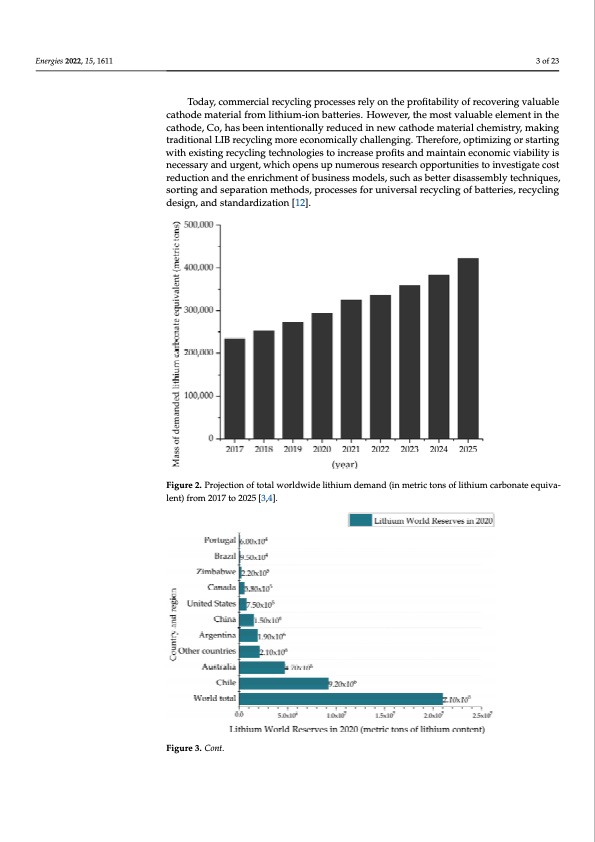
PDF Publication Title:
Text from PDF Page: 003
Energies 2022, 15, 1611 3 of 23 Today, commercial recycling processes rely on the profitability of recovering valuable cathode material from lithium-ion batteries. However, the most valuable element in the cathode, Co, has been intentionally reduced in new cathode material chemistry, making traditional LIB recycling more economically challenging. Therefore, optimizing or starting with existing recycling technologies to increase profits and maintain economic viability is necessary and urgent, which opens up numerous research opportunities to investigate cost reduction and the enrichment of business models, such as better disassembly techniques, 3 of 24 Energies 2022, 14, x FOR PEER REVIEW 3 of 24 Energies 2022, 14, x FOR PEER REVIEW sorting and separation methods, processes for universal recycling of batteries, recycling design, and standardization [12]. Figure 2. Projection of total worldwide lithium demand (in metric tons of lithium carbonate Figure2.PFrigoujercetio2n.Porfotjoetcatilownoorlfdtwotiadlewlitohriludwmidemliathnidum(indmemetarnicdto(ninsomfeltirthiciutmonscaorbfolnitahtieumequcaivrba-onate equivalent) from 2017 to 2025 [3,4]. lent) frome2q0u1i7vatloen2t0)2f5ro[m3,42]0. 17 to 2025 [3,4]. Figure 3. Cont.PDF Image | Recycling of Lithium Batteries

PDF Search Title:
Recycling of Lithium BatteriesOriginal File Name Searched:
energies-15-01611.pdfDIY PDF Search: Google It | Yahoo | Bing
Product and Development Focus for Salgenx
Redox Flow Battery Technology: With the advent of the new USA tax credits for producing and selling batteries ($35/kW) we are focussing on a simple flow battery using shipping containers as the modular electrolyte storage units with tax credits up to $140,000 per system. Our main focus is on the salt battery. This battery can be used for both thermal and electrical storage applications. We call it the Cogeneration Battery or Cogen Battery. One project is converting salt (brine) based water conditioners to simultaneously produce power. In addition, there are many opportunities to extract Lithium from brine (salt lakes, groundwater, and producer water).Salt water or brine are huge sources for lithium. Most of the worlds lithium is acquired from a brine source. It's even in seawater in a low concentration. Brine is also a byproduct of huge powerplants, which can now use that as an electrolyte and a huge flow battery (which allows storage at the source).We welcome any business and equipment inquiries, as well as licensing our flow battery manufacturing.| CONTACT TEL: 608-238-6001 Email: greg@salgenx.com | RSS | AMP |